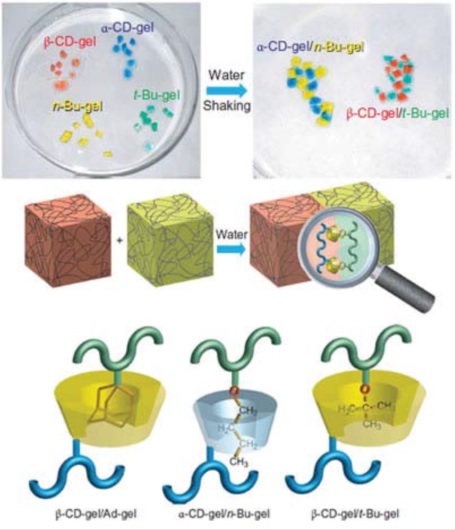Technology to cause natural bonding between arbitrary gels through molecular designing
January 4, 2021
Reversible gel bonding based on molecular recognition
Key Word : self-repair, cyclodextrin (CD)
Background / Context / Abstract:
While self-organization (selective natural bonding) by molecular recognition plays an important role in nature, including nucleic acid base combinations in DNA and antigen-antibody reaction, it is a phenomenon in a size which cannot be visually observed. Meanwhile, there are self-organization phenomena which are visually observable, including magnetic interactions, electrical interactions, hydrophile-lipophile balance and the capillary effect, but none of these employ molecular recognition.
Technology Overview:
This invention is a technology to cause natural bonding between gels of visually observable sizes by molecular recognition through arbitrary combination depending on the host-guest association constant when a gel in which the host group such as cyclodextrin (CD) is attached to the side chain and a gel in which the guest group such as the alkyl group is attached to the side chain are vibrated in a solvent such as water. This invention also enables preparation of gels that can bond again and again to whichever part is dissociated.
Benefits:
1. The host-guest combination can be designed freely.
When α-CD (blue) and β-CD (red) were attached to the host gel and n-butyl (yellow) and t-butyl (green) to the guest gel to be subjected to vibration, bonding occurred in the combinations of α-CD (blue) and n-butyl (yellow), and β-CD (red) and t-butyl (green).
2. Bonding strength can be controlled depending on the combination.
The bonding strength can be designed by the guest-host combination or the number of guest and host groups. For example, the bonding strength is high for gels attached with β-CD and adamantyl and the gel itself failed before the bonding surface in a fracture strength test.
3. Reversible
The bonding separates naturally when a host-guest association inhibitor is used. The gels bond again and again when they are put back into a solution from which the inhibitor has been removed. In addition, they shrink and solidify while maintaining the bond when they are dried in a bonded state, but return to the original condition when they are put back into a solution.
Potential Applications / Potential Markets:
Image for practical application
・Application in new material technology to self-healing
・Application in self-healing material technology indicating the adhesive property depending on oxidation and reduction
・Application in healing technology to bond or separate materials under light irradiation
State of Development / Opportunity / Seeking:
●Opportunity
・Available for exclusive and non-exclusive licensing
・Exclusive/non-exclusive evaluation for defined period (set up for options)
・Collaborative/supportive research
●Seeking
・Licensing
・Development partner
IP Status:
WO2012/036069(Issued: JP, US, US –DIV, EP(GB,DE))
Figures:
Contact:
![]()
